Top News
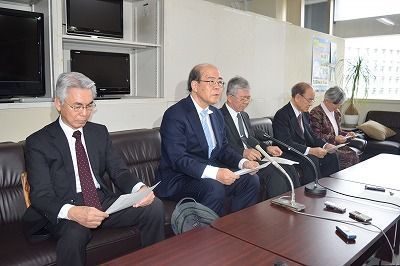
December 27, 2016 Ryukyu Shimpo
On the morning of December 27, the presidents of nine higher education institutions in Okinawa submitted a written statement to the Japanese and U.S. governments in response to the recent crash accident of a U.S. MV-22 Osprey vertical takeoff and landing aircraft on the shore in Abu, Nago, and the belly-landing of an Osprey at Futenma Air Station. The statement demands that the types of U.S. military aircraft that have caused accidents within Japan, including Osprey, be suspended from flying over Okinawan land, among other things. Copies of the statement were sent to Japan’s prime minister and minister of defense, and to the U.S. president and secretary of state.
The presidents of the University of the Ryukyus, Okinawa Christian University, Meio University, Okinawa International University, Okinawa Prefectural University of Arts, Okinawa University, Okinawa Prefectural College of Nursing, Okinawa Women’s Junior College, and Okinawa National College of Technology jointly signed the statement. This statement points out that, “As can be seen in Okinawa Area Coordinator Nicholson’s arrogant comments, the root of the problem lies in the fact that the U.S.-Japan Status of Forces Agreement (SOFA) allows the U.S. military to freely use bases in Okinawa.” In addition to the suspension of flights, the statement is calling for investigations into the causes of the two serious incidents, preventative measures for such occasions, the suspension of Osprey training using the helipads in the Northern Training Area, and revision of the U.S.-Japan SOFA.
President of the University of the Ryukyus Hajime Oshiro, president of Okinawa Christian University Hiroshi Tomori, president of the Prefectural University of Arts Yasuharu Higa, president of Okinawa University Hiroshi Nakachi, and president of the Prefectural University of Nursing Eiko Kadekaru gave an interview at the correspondents’ club at the Okinawa Prefectural Government Office on the same morning as the submission of the written statement. Tomori said that there is a problem with the Japanese government’s stance since accidents repeatedly occur. He emphasized that their written statement is, in other words, a declaration of protest. Nakachi said, “For the safety of students, universities, Okinawan residents and regions, we must, as people of higher education, make our voices heard.”
(English translation by T&CT and Erin Jones)
Go to Japanese
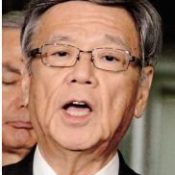
December 28, 2016 Ryukyu Shimpo
(Tokyo) On the morning of December 27, Governor Takeshi Onaga had a meeting with Chief Cabinet Secretary Yoshihide Suga, where he called for prior discussions to be held before the government resumes construction work for the relocation of U.S. Marine Corps Air Station Futenma to Henoko. However, several hours after the meeting, the government resumed construction for the new base. The governor criticized the move as proceeding forcefully and said, “Things cannot move forward so simply. I hope to take [countermeasures] in various ways. I absolutely won’t let the new base be built in Henoko.” He added, “I will need to take drastic measures [in order to prevent the base construction],” once again indicating his intent to take any means necessary to prevent the new base construction.
According to the governor, at the meeting, Suga suggested that the construction would resume swiftly, saying that discussion may be necessary but that the government’s policy is in place. Onaga said, “Okinawa has its own position. We each have our own position, and if we can’t engage in discussion, it will be very problematic, so I really hope we can discuss the issue.”
Around 2 p.m., after the construction resumed, the governor spoke to reporters again, mentioning the fact that U.S. military installations in Japan are heavily concentrated in Okinawa and expressing anger, saying, “They have kept [the bases] here for more than 70 years, and now they want to keep them here for even longer. At this rate, they might keep them here for yet another 70 years. Can they really allow this to happen to fellow Japanese citizens?”
Onaga then spoke about the U.S. military’s Northern Training Area, mentioning that when part of it was agreed to be returned as part of the Special Action Committee on Okinawa (SACO) agreement, there was no plan for the remainder to be used for Osprey training, and a survey of the impact of Osprey training was left out of the environmental impact assessment. “This time, [with no prior discussion], the same thing is happening,” Onaga said, expressing his view that the government is pushing forward forcefully with the construction.
(English translation by T&CT and Sandi Aritza)
Go to Japanese
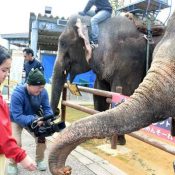
December 22, 2016 Ryukyu Shimpo
A welcome ceremony for two Asian elephants, Tonsai and Buntoon, from Tohoku Safari Park in Fukushima was held on December 17 at the Okinawa Zoo & Museum. The elephants are staying in Okinawa to see out the winter. The curator of the zoo, Masaru Takada, greeted visitors, saying, “Please enjoy yourselves and learn many things with them.” Children climbed up the elephants’ backs and fed them carrots. The elephants will stay in the zoo until next March.
This is the third wintering for the elephants at the Okinawa Zoo & Museum. Tonsai has an adorable and well-rounded body, and Buntoon has a thin body and long legs. The two elephants have been on loan from Laos for three years as a gesture to cheer up the areas affected by the Great East Japan Earthquake. Children feeding the elephants said that it was fun and that they were surprised by the elephants’ size.
The president of the safari park Nobushige Kumakubo said, “The two elephants like sugar cane and were looking forward to visiting Okinawa.”
(English translation by T&CT and Sayaka Sakuma)
Go to Japanese
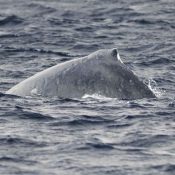
December 26, 2016 Ryukyu Shimpo
By Yoshikazu Miyazato
On December 25, it was confirmed that a humpback whale visited the northern sea of Zamami Island. It is the first whale sighting of the season.
Kiyoshi Miyagi, 57, a member of the Zamami Whale Watching Association, managed to take a photograph.
The humpback whale appeared in the sea off the coast of the island.
The whale swam around the island for a while, eventually heading north.
The whale watching association will open its office on December 27.
Zamami Village has kicked off the whale-watching season, which continues till March next year.
(English translation by T&CT)
Go to Japanese
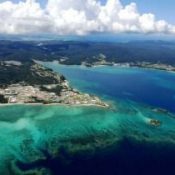
December 26, 2016 Ryukyu Shimpo
At 1:30 p.m. on December 26, Okinawa Governor Takeshi Onaga held a press conference at Naha Airport and announced that he had begun procedures to cancel his cancellation of authorization to reclaim land in Henoko, Nago City. Onaga cancelled the authorization in October of last year. On the same day, the Okinawa prefectural government sent notice of the cancellation to the Okinawa Defense Bureau. As soon as the notice reaches the Defense Bureau, former Governor Hirokazu Nakaima’s authorization of the Henoko land reclamation, which he made in December 2013, will regain force. The Okinawa Defense Bureau plans to resume reclamation work as early as December 27. The work has been suspended since March 4 of this year, when the prefectural and national governments reached an out-of-court settlement in a proxy execution lawsuit.
The measure of cancelling the cancellation of the authorization is being taken in light of a Supreme Court decision made on December 20. The Supreme Court decision declared that there was nothing particularly unreasonable about the Henoko reclamation plan or the environmental measures planned by the Defense Bureau, and judged Governor Onaga’s cancellation of the authorization to be illegal. Governor Onaga had announced that he would abide by the
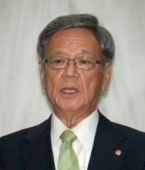
Governor Takeshi Onaga
final decision regarding the cancellation of the authorization.
At the press conference on December 26, Governor Onaga said, “Now that the Supreme Court ruling has been made, I will construct a new direction in which to proceed from a steady foothold. I entered into the court battle knowing there were other areas where I can assert my authority as governor, so I want to continue to work toward preventing the construction of a new base in Henoko and getting the Osprey removed from Okinawa.”
Of comments made by Chief Cabinet Secretary Yoshihide Suga at a separate press conference on December 26 that “the necessary preparations are in place” for resumption of the Henoko construction, Onaga was critical, saying, “resumption of construction should happen after engaging in more discussion.”
At his press conference, Onaga reemphasized that although he will abide by the Supreme Court ruling regarding the cancellation of the land reclamation authorization, there is no change in his intent to continue to use all means at his disposal to prevent the construction of a new base in Henoko. The focus will now be on what method Governor Onaga will use to prevent the construction as the national government begins construction in earnest for the relocation to Henoko of MCAS Futenma both on land in Camp Schwab and at sea when the new year begins.
(English translation by T&CT and Sandi Aritza)
Go to Japanese
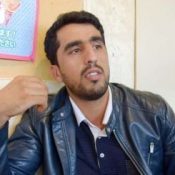
December 25, 2016 Ryukyu Shimpo
On the evening of December 23, false rumors that a male proponent of the extremist organization Islamic State (IS) from Afghanistan would incite terrorism in Mihama, Chatan Town were flying around on social networking sites (SNS) such as Twitter. The post spread had an attached photograph of 30-year-old Ahmad Milad with the words “IS proponent.”
In an interview with Ryukyu Shimpo, Milad said: “I have never planned to engage in terrorism and I have no connection at all to IS. I am shocked and I do not know why [this rumor] was spread.” He mentioned his intent to lodge criminal defamation charges at the beginning of the next week.
Okinawa prefectural police announced that they had found the post itself, but not the origin. Between now and the end of the year prefectural police are strengthening their efforts and closely monitoring common channels. An expert pointed out that this not only involves the person who sent out the false rumor, but those who have allowed it to spread are complicit.
Milad came to Japan seven years ago, and has been living in Okinawa for two years as a used car salesman.
The post in question was made after 7:00 p.m. on December 23, then reproduced and spread in English messages on Twitter to employees of shops run by the Army and Air Force Exchange Service (AAFES). Even in Japanese messages containing writing such as, “An Islamic State proponent is hinting at an act of terrorism near American Village, targeting officials of the U.S. Armed Forces.” Milad’s profile picture from Facebook was used without his permission and attached to these messages. There were several posts on Twitter, which were retweeted over 800 times.
A friend of Milad’s who attends the same boxing gym, 24-year-old Noriyuki Taira of Okinawa City, accompanied Milad to a consultation of damages with the police concerning defamation charges. Taira said that it is mortifying that his colleague who he practices with has been made out to be a dangerous person. Twenty-year-old Mufasa Hassan of Uruma City, who immigrated with Milad, also attended the consultation. Hassan made the point that, “There is prejudice against Islam and Afghanistan.”
Managing Director Satoru Okuhara of Okuhara Shoji Company, which manages American Village, showed concern over the matter. He said that it is still unknown what the effects of the rumors will be, but that they are worrisome.
Board chairman Masashi Yasukawa of a website that provides informed details on internet troubles said, “Even if they thought it was true, those who spread the rumor [are guilty of] complicity.” He went on to advise that, “It is essential to consider why the [post’s] originator is in possession of the information and the image.” In addition, he insisted that the originator’s credibility must be ascertained.
(English translation by T&CT and Erin Jones)
Go to Japanese
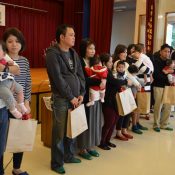
December 25, 2016, Ryukyu Shimpo
The Kyan community association in Itoman, Okinawa held their annual newborn celebration, “Chiritancho” on the afternoon of December 25 in the Kyan Community Center. The celebration is for babies born in 2016, and wishes them a long, healthy life. Sixteen of the 25 babies born this year in Kyan participated with their parents, and were celebrated by local residents.
Chiritancho is a traditional event with Christian influences that has been celebrated in Kyan for 340 years. After introducing each newborn individually, Kajadefu and youth-group Eisa dances are performed in celebration.
Akira and Amari Motomura, parents of 8-month old Hikari, one of the participants, said happily of the celebration, “It’s great that the entire community comes together to value children. This is our first child, so we want her to grow up healthy and thrive. We hope that this celebration stays with her until she grows bigger.
Kouei Geruma, head of the community association, added, “We hope to raise children to feel a kinship with Kyan as well as spread their wings and soar throughout the globe. I want this event to continue hereafter.”
(English translation by T&CT and Sam Grieb)
Go to Japanese
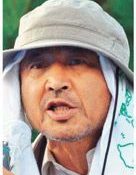
December 24, 2016 Ryukyu Shimpo
Hiroji Yamashiro, the director of the Okinawa Peace Movement Center, who was arrested on October 17, has been prosecuted and is now being detained for his involvement in protests against new U.S. base construction in Henoko, Nago and Helipad construction in the U.S. marines’ Northern Training Area (NTA) in Takae, Higashi. He responded to interview requests made by the Ryukyu Shimpo through a lawyer who has been representing him.
On December 24, the Ryukyu Shimpo sent him questions, and received his response in writing on the same day.
Yamashiro emphasized the importance of continuing the movement and not giving in to the central government’s hardline stance on building the new base and the helipads. “Now is the time to support Governor Onaga. Let’s join our hands to work for the future of Okinawa. The future is ours,” he states in his response.
“I feel unexplained anger,” He says. He denounced the Osprey crash and called for the unity of Okinawan people, “Let’s unite and exercise the power of the prefecture’s people to stop this reckless chain of fear.”
Touching on a ceremony held on December 22 for the return of part of the northern training area, Yamashiro expressed his feelings, “I was so moved emotionally that tears were coming out of my eyes when I heard that Governor Onaga had publicly taken part in the citizens’ protest gathering with a resolute attitude, refusing to attend the ceremony. I remember the strength that I felt.”
He stated, regarding the arrest of many protesting citizens including himself, “I cannot help but say that it is unforgivable repression.”
He wrote about the future, “I am waiting for the day I will proudly raise my voice in protest together with colleagues. I will do my best here.”
(English translation by T&CT)
Go to Japanese
December 20, 2016 Ryukyu Shimpo
On December 19, Okinawa Prefecture’s Culture, Tourism, and Sports Division announced the economic effects of tourism in Okinawa in the 2015 fiscal year. Tourism generated 1,143,334 million yen, a rise of 49.9 percent from the survey last year, and the highest number ever. This is the first the figure that has exceeded one trillion yen. The increase in foreign tourists and the number of landings of large cruise ships, and rising spending per person contributed to the record number. Tourism spending, used as the basis for calculating the economic ripple effect, was 691.1 billion yen, a rise of 51.2 percent from that in 2012.
The economic ripple effect of tourism mainly benefits the accommodation and restaurant industries directly involved with tourists. There were also direct and indirect effects on employment, with 125,749 jobs, an increase of 51.2 percent (approximately 44,000 people) from 2012. This is equivalent to 18.2 percent of employees in Okinawa.
Tourism expenditure is calculated by multiplying the number of tourists within Okinawa and from other prefectures and overseas by 75,881 yen (an average visitor’s spending).
(English translation by T&CT and Megumi Chibana)
Go to Japanese
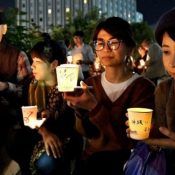
December 22, 2016 Ryukyu Shimpo
At Kenmin Hiroba in Naha on December 21, citizens took part in a candlelit protest to denounce a U.S. Marine MV-22 Osprey crashing off east coast of Nago and Japan’s Supreme Court ruling against Okinawa Prefecture in a lawsuit over the relocation of Futenma air base which would mean a new base in the already base-burdened island. Those who gathered lit paper candles as a powerful symbol of their protest. Candlelit protests were also held in front of Nago Police station as well as in the Prefectures of Hyogo and Fukuoka.
The protest was held following Okinawa Prefecture’s defeat in the lawsuit over the legality of the relocation brought by the national government against Okinawa in response to Governor Takeshi Onaga’s retraction of permission to reclaim land for the base in Henoko, Nago City. The Second Petty Bench of the Supreme Court announced their judgement of Okinawa’s appeal without listening to any testimony that would have been needed to overturn the initial verdict. The protest against the verdict event was arranged through social media.
(English translation by T&CT)
Go to Japanese
December 23, 2016 Ryukyu Shimpo
For whose sake is the land being returned? The return can only be declared a deceptive farce devised by the U.S. military and the Abe administration.
At the ceremony celebrating the return of more than half of the U.S. military’s Northern Training Area, Chief Cabinet Secretary Yoshihide Suga stated, “This is the largest return of land since Okinawa was returned to Japan. Roughly twenty percent of U.S. military facility land in Okinawa is being returned, contributing greatly to the reduction of burden on Okinawa.”
It is utterly unacceptable to disguise an increase in the burden borne by Okinawa, in the form of strengthening the function of U.S. bases in Okinawa, as a “reduction of burden” by focusing solely on the area of land to be returned.
We cannot allow December 22, 2016 to go down in history as yet another “Day of Humiliation.” We must rather turn it into a starting point to win a real reduction of burden.
Logic of new base construction and contradictions
At the ceremony, Suga stated that the Special Action Committee on Okinawa (SACO) agreement of 1996 between Japan and the U.S. was the starting point for the return of roughly 4,000 hectares of the Northern Training Area. He should have looked back further to the Battle of Okinawa.
After Okinawans were embroiled in the tragic Battle of Okinawa, turned into a sacrificial stone for the protection of the Japanese mainland, their land was forcibly seized by the U.S. military. Given that reality, there is no way the present action could be nonchalantly declared a “reduction of burden.”
Suga said, “After 20 years, we have finally been able to achieve the return.” In fact, he should have apologized for the fact that it took so long to achieve the return of land that the U.S. military considers “unusable.”
The return of more than half of the Northern Training Area is conditioned on the relocation of six helipads in locations so that they will surround the hamlet of Takae in Higashi Villgae. Osprey are already training there regularly. Noise problems at night are becoming more severe, leading to children having to miss school due to lack of sleep.
Looking at the situation in Takae, it is clear that the present land return, conditioned on the helipad relocation, is merely a farcical “reduction of burden.”
The government says that in order to remove the dangers posed by U.S. Marine Corps Air Station Futenma, it must proceed with the construction of a relocation facility in Henoko, Nago City, which has a smaller population. However, in the case of the Northern Training Area, it is doing exactly the opposite. Helipads located in a forested area are being relocated to near a hamlet, which contradicts the logic for building a new base in Henoko.
Suga admitted that a burden is being forced on residents, saying, “We will continue to cause you inconvenience with the helipad relocation.” This is what the Abe administration calls a “reduction of burden.”
Defense Minister Tomomi Inada said at the ceremony, “In light of the [recent] Osprey accident, we will endeavor to ensure full consideration of the local living environment, such as through avoidance of flights directly over the hamlet.” We are not hopeful.
The Ministry of Defense asked the U.S. military to stop doing dangerous exercises that involve suspending objects by cables from Osprey over residential areas. However, the U.S. military continued such exercises anyway. The Japanese government is powerless to prevent the U.S. military from conducting dangerous training exercises.
Only natural for governor not to attend ceremony
In contrast to the return ceremony, where empty seats stood out, a protest rally held on the same day, organized by the All Okinawa Coalition, which comprises political parties and civic groups, to demand removal of the Osprey was full of fervor.
At the rally, Governor Takeshi Onaga expressed his determination in Uchinaguchi, saying, “We must bring our hearts together as one. For the sake of our children and grandchildren, we can’t lose. If a new base is not built in Henoko, we will also be able to have the Osprey removed. We must do our best to prevent [the Henoko base] from being built.”
As concerns about the excessive burden of bases increases, many Okinawans were surely encouraged by the governor’s call for Okinawans to persist in their struggle.
After the return ceremony, Chief Cabinet Secretary Suga said, “It is very unfortunate that the governor, who calls for a reduction of the base burden, is unable to attend.” If he is unable to recognize the significance of the governor’s absence from the ceremony, he is not qualified to be the Minister in charge of Alleviating the Burden of the Bases in Okinawa.
It is only natural that the governor did not attend the ceremony. It is rather strange that Suga expressed discomfort with the governor’s absence. He should realize that by pressing forward with the return ceremony immediately after an Osprey crash incident, the government was mocking the people of Okinawa.
What Okinawa demands is the guarantee of a living environment where children can grow up in sound health. The present land return will not lead to a safe living environment. Many Okinawans, not only those who attended the protest rally, know this.
It is Okinawans who will be the ones to open a path to Okinawa’s future. We should once more pledge to use our power as Okinawans to resist oppression.
(English translation by T&CT and Sandi Aritza)
Go to Japanese










 Webcam(Kokusai Street)
Webcam(Kokusai Street)


